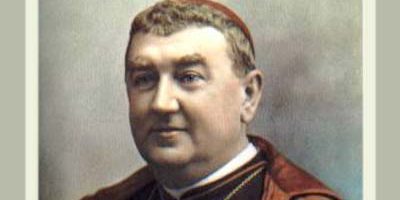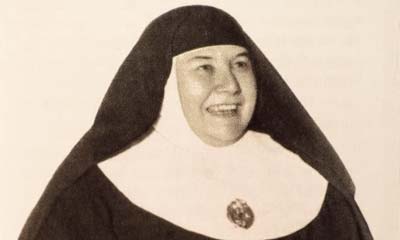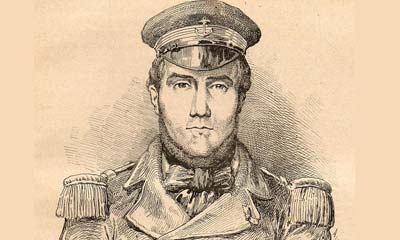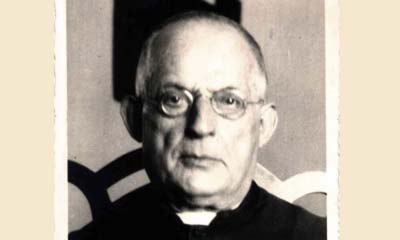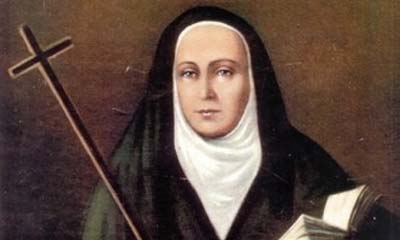March 6, 2024
Saint Manuel Gonzalez Garcia
Dear Friends,
“I do ask to be buried next to a tabernacle, so that my bones, after my death, even as my tongue and pen during my life, may continue to say to those who pass by: here is Jesus! He is here! Do not abandon Him!” This epitaph was composed by Bishop Manuel González, to be inscribed on his tomb in the Blessed Sacrament Chapel of Palencia Cathedral (Spain). The man who has come to be known as the “Bishop of the Eucharist” or the “Bishop of Abandoned Tabernacles” was canonized by Pope Francis on October 16, 2016.
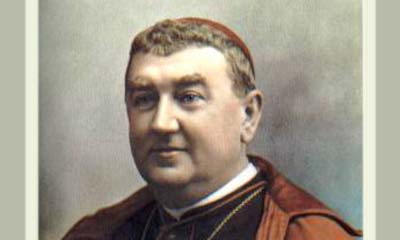 Manuel González García was born on February 25, 1877 in Seville (Spain), into a humble and devout family. His father, Martín González Lara, originally from Malaga, had recently opened a carpentry and cabinetmaking workshop, while his mother, Antonia García, looked after their home and children. Manuel was the fourth of five siblings. He was baptized three days after his birth. Antonia took great care of her children, inspiring them in particular with a tender devotion to the Blessed Virgin. Manuel attended private primary schools, after which he entered the College of San Miguel in Seville where the cathedral’s choirboys were educated. He was not yet ten years old when he became one of the “seises” of Seville Cathedral, a group of six altar boys who, in keeping with the city’s immemorial tradition, dance and sing before the Blessed Sacrament during celebrations for Corpus Christi and the Immaculate Conception.
Manuel González García was born on February 25, 1877 in Seville (Spain), into a humble and devout family. His father, Martín González Lara, originally from Malaga, had recently opened a carpentry and cabinetmaking workshop, while his mother, Antonia García, looked after their home and children. Manuel was the fourth of five siblings. He was baptized three days after his birth. Antonia took great care of her children, inspiring them in particular with a tender devotion to the Blessed Virgin. Manuel attended private primary schools, after which he entered the College of San Miguel in Seville where the cathedral’s choirboys were educated. He was not yet ten years old when he became one of the “seises” of Seville Cathedral, a group of six altar boys who, in keeping with the city’s immemorial tradition, dance and sing before the Blessed Sacrament during celebrations for Corpus Christi and the Immaculate Conception.
Manuel received his first Holy Communion when he was eleven, and from then on faithfully kept the habit of frequent Communion. Shortly afterwards, he was confirmed by the Cardinal Archbishop of Seville. He became a minor seminarian at the age of twelve, having already written of his desire to be a priest with these words: “If I were born a thousand times, a thousand times would I be a priest.” The young boy adjusted well to his boarding school life, achieving excellent results in all subjects. His cheerful nature led him to take the lead at recess and on community outings. He was also responsible for making nightly rounds of the buildings as a precaution against intruders and to check that doors and windows were securely closed; this involved walking through vast empty corridors with a flickering lantern. Manuel would later admit that this service was very distressing to him, although he never complained at the time. He often visited the Salesian oratory, and would retain a great affection for the sons of Don Bosco and their devotion to the Virgin Mary Help of Christians.
In 1894, Manuel accompanied the national workers’ pilgrimage to Rome with a group from Seville to mark Pope Leo XIII’s episcopal jubilee. In anticipation of the trip he had learned Italian, which enabled him to be of great service. The Holy Father, whose emaciated face greatly impressed the young seminarian, celebrated Mass for the pilgrims. On his return to Seville, along with his professor of dogmatic theology, Manuel contributed to the Catholic newspaper El Correo de Andalucía, whose founder, Marcel Spinola, a future cardinal, was beatified in 1987 by Pope John Paul II. Manuel’s articles were signed by the pseudonym “Gonzalo de Sevilla”. When he graduated, he obtained a doctorate in theology and was ordained to the priesthood on September 21, 1901, at the age of twenty-four; he entrusted himself to the intercession of Mary Help of Christians. Generous contributions from well-to-do families in Seville enabled him to raise enough money to avoid military service. During the first year of his priesthood, the young priest studied canon law, earning a licentiate, and served as chaplain in a home for the elderly run by nuns. Energetic by nature, he preached in Seville’s parishes and in the countryside in addition to his studies.
Early in 1902, the Archbishop of Seville sent him to preach a mission in Palomares del Rio, in the diocese: there he found a sadly abandoned church with dust, dirt and cobwebs right up to the interior of the tabernacle, while the altar cloths were in a sorry state. He later recalled: “I went straight to the tabernacle… and what a tabernacle, my God! What an effort my faith and courage had to make not to escape back home! But I did not flee. There, on my knees… my faith saw a Jesus so quiet, so patient, so good, gazing right back at me… His gaze was telling me much and asking me for more. It was a gaze in which all the sadness of the Gospel was reflected… The gaze of Jesus Christ in his tabernacles is a gaze that pierces the soul and is never forgotten. For me, it became the starting point for seeing, understanding and feeling the whole of my priestly ministry.” The grace he thus received inspired him and turned him towards Eucharistic works.
Reawakening Christian Life
In 1905, he was appointed parish priest of the main parish, San Pedro de Huelva, and in the same year was named archpriest (the priest in charge of a group of parishes called a deanery). He faced an attitude of religious indifference among many, but his love and resourcefulness led him to introduce schemes designed to reawaken Christian life. He organized novenas, for instance, which served as genuine parish retreats. In 1906, at a meeting of clergy, nuns and lay people, he won unanimous commitment to uphold the Assumption of the Virgin Mary, thereby anticipating the proclamation of this dogma by Pius XII in 1950. He also organized conferences to promote a better understanding of the dogma of the Immaculate Conception. New confraternities were created, including those dedicated to St Joseph and the Blessed Virgin. In 1906, echoing his work with El Correo de Andalucía, he founded the magazine El Granito de Arena (literally “the little grain of sand”, “our grain of salt”) in order to counterbalance the influence of local anti-clerical societies. At this time, he published the first of his many books: Lo que puede un cura hoy (“What a priest can do today”), which would become a classic.
In 1908, having noticed how many children were roaming the streets, he founded Sacred Heart of Jesus schools for boys and for girls. Among his collaborators was a lawyer, Manuel Siurot, who gave up a splendid career to teach the younger classes. The better to organize school life, Fr González did not hesitate to visit similar works in Granada and Seville. That same year, with the help of a group of young women, he set up a school and chapel in the outskirts of the city. His work attracted attention and prompted a request for a lecture at the Third Social Weeks of Spain, which took place in Seville in 1910.
It was on March 4, 1910, while addressing a group of faithful collaborating in his apostolic activities, that he expressed the great desire of his heart: “Allow that I, who so often invoke the solicitude of your charity on behalf of poor children and all the abandoned poor, may today appeal for your attention and cooperation on behalf of the most abandoned of all the poor: the Blessed Sacrament. I ask you for the alms of your affection for Jesus Christ in the Blessed Sacrament… For the love, so little shared, of Mary Immaculate and of this Heart, I ask you to become the Marys of these abandoned tabernacles.” And so, the “Obra para los Sagrarios-Calvarios” (Work of the Tabernacle-Calvary) was born, with its feminine branch, “Marys of the Tabernacles”, a name that refers to the “Three Marys” who accompanied Jesus to the rock of Golgotha (Standing by the cross of Jesus were His Mother and His Mother’s sister, Mary the wife of Clopas, and Mary of Magdala—Jn 19:25), and later a masculine branch, the “Disciples of St John”. Its purpose was to offer a response of love and reparation to the love of Christ in the Eucharist. Its primary aim was the visiting and caring for tabernacles, as well as church sanctuaries, in view of Eucharistic worship. In 1912, Manuel launched the “Juanitos” and “Juanitas”, a work of Eucharistic reparation by children.
A Most Precious Presence
“The worship of the Eucharist outside of the Mass is of inestimable value for the life of the Church,” wrote Pope John Paul II. “This worship is strictly linked to the celebration of the Eucharistic Sacrifice. The presence of Christ under the sacred species reserved after Mass—a presence which lasts as long as the species of bread and of wine remain—derives from the celebration of the sacrifice and is directed towards communion, both sacramental and spiritual. It is the responsibility of Pastors to encourage, also by their personal witness, the practice of Eucharistic adoration, and exposition of the Blessed Sacrament in particular, as well as prayer of adoration before Christ present under the Eucharistic species.
It is pleasant to spend time with him, to lie close to his breast like the Beloved Disciple (cf. Jn 13:25) and to feel the infinite love present in his heart. If in our time Christians must be distinguished above all by the ‘art of prayer’, how can we not feel a renewed need to spend time in spiritual converse, in silent adoration, in heartfelt love before Christ present in the Most Holy Sacrament? How often, dear brother and sisters, have I experienced this, and drawn from it strength, consolation and support!
This practice, repeatedly praised and recommended by the Magisterium, is supported by the example of many saints” (Encyclical Ecclesia de Eucharistia, April 17, 2003, no. 25).
Founded in Huelva, the Work of the Tabernacles spread throughout Spain, Portugal and Belgium. It then crossed the Atlantic, reaching Cuba in 1913, followed by Argentina, Venezuela, Mexico and others. The rapid spread of the Work prompted Manuel González to ask the Pope for his approval. He went to Rome at the end of 1912, and on November 28 was granted an audience with His Holiness Pius X, to whom he was introduced as “the apostle of the Eucharist”. Saint Pius X showed great interest in all his apostolic activity and blessed the Work. In December 1915, Pope Benedict XV appointed González auxiliary bishop of Malaga; on the following January 16, he was ordained bishop in the cathedral of Seville by Cardinal Almaraz y Santos. He soon embarked on an apostolic visitation of the diocese of Malaga, a task the ageing bishop was no longer able to fulfill. For the following eight months, Bishop Gonzáles applied himself diligently to this task. In January 1918, he founded the “Diocesan Eucharistic Missionaries” as an extension of the “Disciples of St John” who were to become a seedbed for vocations for the new group. On February 1, he gave the priests a pastoral instruction on their aims, means and actions. They were to go from parish to parish, preaching and confessing.
On March 22, 1920, González was appointed titular bishop of Malaga by Pope Benedict XV. The prelate decided to celebrate the event by hosting a banquet for poor children, rather than for the authorities. Three thousand children were welcomed and served by priests and seminarians. Then, as the first act of his episcopate, he organized a procession to the Virgin of Victoria, patron saint of Malaga. This representation of the Virgin Mary seated with her Divine Child on her lap, was executed to commemorate the city’s liberation from Moorish domination in the 15th century.The bishop visited the shrine every Saturday from then on. He soon set about reviving local schools and parish catechism classes. His preaching in the street, which he practiced by talking to everyone he met, convinced him that the most urgent need was for priests.
The Eucharist as a Cornerstone
With boundless confidence in the Sacred Heart of Jesus, he undertook the construction of a new seminary from 1920 to 1924. He desired to establish “a seminary that would be Eucharistic in its very substance, and where the Eucharist would be the most effective stimulus for pedagogy; the foremost teacher and subject for science; the most vigilant inspector for discipline; the most vivid model for the ascetic life; the great providence for economic matters; and the cornerstone of its architecture.” Dedicated to the Eucharistic Heart of Jesus, the seminary had the tabernacle at its center. The bishop wanted it to be clearly and functionally designed, more like a village than a large establishment. To this end, he chose a beautiful site in the hills overlooking the episcopal city. Funds were not easy to come by. However, popular support for the seminary’s construction was significant, and included donations in kind, such as stones. Volunteers worked on the site, including seminarians who became masons and carpenters during their vacations. The prelate diligently attended to everything, including the water supply.
Discerning genuine vocations in a context of declining numbers of seminarians and ageing clergy was one of his priorities. He wanted to give them a human, spiritual and intellectual formation, but above all he desired that they should become apostles. Professors were selected with care for their godliness and science. Young priests were sent to complete their training at the pontifical academies in Rome and Comillas in Castile. Bishop González suggested to his priests and the members of his various foundations a path to holiness that consisted in “becoming a host in union with the consecrated Host,” which means “giving oneself to God and one’s neighbor in the most absolute and irrevocable way.” In his eyes, the devotion to the Sacred Heart and the Eucharist were inseparable. He employed every means to foster them. He adopted the expression “the Heart of Jesus made Sacrament” as the theme of his first pastoral letter to his diocese. Following in the footsteps of Saint Teresa of Avila, he wrote: “My Jesus is not loved because my Jesus is not known,” adding: “and is not received in the Eucharist.”
Evangelizing through the Eucharist
Bishop González was well aware of the state of disrepair of many of the churches in his diocese, but also of the poverty of many priests and the lack of solemnity in worship. The sovereign excellence of God, who is the origin and ultimate end of man and all creation, must be celebrated through worship. For this reason, the Church has always taken great care in adorning its temples, in order to magnify the Lord whom they shelter, hidden in the Holy Eucharist. The first to benefit from this beauty have always been the poor. In order to remedy the ills he had observed, Bishop González set about refocusing parishes on Divine Love, and began by gathering together a small group of devoted souls who would be like leaven in the dough. Some of the “Marys of the Tabernacles” were eager to devote their entire lives to caring for Jesus in the Eucharist. Having experienced how much God loved them, they wanted to bear witness to this with their lives. Together with his sister, María Antonia, Bishop González formed this group of women into a community on May 3, 1921; they were the first “Marias Nazarenas” who would later become the congregation of the “Eucharistic Missionaries of Nazareth.” They were called Eucharistic women, meaning they were sent to evangelize through the Eucharist, in the style of the Holy Family of Nazareth: simple, fraternal, devoted to prayer, joyful, grateful and dedicated.
Thanks to the ministry of the priests of his diocese and neighboring dioceses, many souls were returning to a life of grace. The movements founded by Archbishop González led to the formation of a large number of Eucharistic adorers, who devoted themselves to visiting tabernacles and worshipping at expositions of the Blessed Sacrament. Bishop González was particularly attached to nocturnal adoration by men, and one day exclaimed, “I want the determined cooperation of courageous men!” Indeed, in his episcopal city, there were sufficient adorers to organize perpetual adoration. At the same time, he developed the Work of the Tabernacle-Calvary by organizing deanery and diocesan meetings. The mustard seed planted in the parish of San Pedro de Huelva had matured into a tree of considerable size. At a Eucharistic Congress in Toledo, thousands of “Disciples of St John” and three thousand “Marys of the Tabernacles” attended. The latter lent their active and very useful support to the organization of missions.
But then the revolution began to spread throughout Spain. In April 1931, the Republic was proclaimed. On May 11 and 12, anti-clerical groups set fire to numerous religious buildings in Malaga. On the night of the 11th, one group torched the bishop’s palace. The bishop and all those staying there, having consumed all the hosts in the tabernacle, escaped and hid in a priest’s house. The episcopal palace was destroyed, along with its archives and artistic treasures. Bishop González himself was forced to leave the city, and made his way to Gibraltar, where he was welcomed by the diocese’s English bishop. “Lord Jesus, forgive us and your people! Have mercy on we who have sinned and accept the sacrifice of our lives for your Kingship in Spain, especially for the diocese! Immaculate Mother, save our souls, take us by the hand!” This marked the beginning of a period of wandering, during which he made short visits to the outskirts of his diocese, as well as an ad limina visit to Rome, where he noted that the Pope was following developments in Spain with great attention and concern. In a meeting with the nuncio, the latter informed him of the situation in Malaga and advised him not to return there, but to govern his diocese from Madrid. Here, the bishop was hosted by a noble family whose home contained a chapel with the Blessed Sacrament.
As a Resurrection
On August 5, 1935, Pius XI named Bishop González to the see of Palencia, a city over 120 miles (200 km) north of Madrid. He took leave of Malaga through a letter to the clergy and another to the seminary, then entered Palencia on October 12, the feast of Our Lady of the Pillar of Saragossa. He was warmly welcomed. After his expulsion from Malaga and his Way of the Cross as an exile, he perceived his arrival in Palencia as a resurrection. His first visit was to the seminary, dedicated to St Joseph. He went on to visit the parishes of the diocese, which he toured from end to end. He took particular care in assessing the condition of their churches and especially of the tabernacles. Everywhere, he recommended the development of Eucharistic worship and of the catechism. He sent for members of his Eucharistic Societies from Madrid to set up chapters in the diocese. On January 1, 1937, he launched his last magazine, Reina, for children; then, in 1939, in the wake of the Spanish War which had been marked by numerous desecrations of the Blessed Sacrament in the Republican-controlled zone, and against the backdrop of the outbreak of the Second World War, he founded the “Eucharistic Youth for Reparation”. He clearly stated that wars are the punishment for sins. The new movement was intended to save the country from this scourge, through the prayers and voluntary sacrifices of children, following the example of the three little shepherds who saw Our Lady in Fatima in 1917.
Bishop González felt his death approaching. His desire for Heaven increased. He had suffered from headaches all his life, but now they were becoming worse. He was very unwell on his return from a pilgrimage to Our Lady of the Pillar. On December 31, 1939, he was admitted to the Rosario sanatorium in Madrid, where he suffered with equanimity and resignation. On the following January 4, very early in the morning, he received Communion for the last time. The nuncio visited him, but he could only respond with a smile. His brother came to see him and placed in his hands the Virgin of Joy, from the parish where he had been baptized in Seville; he recognized it, then fell asleep in death.
“Manuel González is a model of Eucharistic faith whose example continues to speak to the Church today”, said Pope John Paul II in the homily for his beatification (April 29, 2001). Let us imitate this Saint in his constant encounters with the Lord in the Blessed Sacrament, where we can draw all the graces we need to reach the place where the Angels and Saints see Him face to face (1 Cor 13:12).


